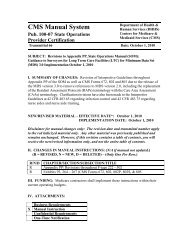LOUISIANA Community Mental Health Services Block Grant ...
LOUISIANA Community Mental Health Services Block Grant ...
LOUISIANA Community Mental Health Services Block Grant ...
You also want an ePaper? Increase the reach of your titles
YUMPU automatically turns print PDFs into web optimized ePapers that Google loves.
which has been put to the test with the current response to the oil spill caused by the explosion of the<br />
British Petroleum rig in the Gulf. Collaborative relationships exist with local chapters of the Red<br />
Cross, Office of Homeland Security, Emergency Preparedness, the Office of Public <strong>Health</strong>, and the<br />
National Guard as well as other emergency management organizations. Regions/ LGEs have<br />
conducted statewide drills, meetings, and exercises with these entities to ensure an understanding of<br />
roles, responsibilities, and operations.<br />
In examples of more specific service offerings, OBH provides staff members to all state-administered<br />
hospital emergency rooms. These staff members perform mental health screening as part of the<br />
admission process. OBH coordinates in-service training for emergency room doctors, nurses and other<br />
professional and para-professional staff. OBH also trains teachers and school administrators in disaster<br />
response procedures.<br />
OBH, jointly with the Office of Emergency Preparedness, provides training to parish level police/ fire/<br />
EMS workers charged with disaster response. Such training includes:<br />
Critical incident management, <strong>Mental</strong> health disaster services, Bio-terrorism preparedness,<br />
<strong>Mental</strong> health response to mass casualties, Coordination of mental health and first responders,<br />
Stress management for first responders.<br />
Regions and LGEs report that they are very engaged and involved in activities involving crisis and<br />
emergency planning, and they are linked with cooperative agreements to other agencies. First<br />
responder teams have been developed in some regions, and regions have plans and procedures for<br />
staffing medical special needs shelters in the event of a crisis that requires evacuation. Communication<br />
needs for staff have resulted in extensive uses of technology. Many staff members have been issued<br />
cell phones and blackberries that can be used in emergencies. In addition, 800 Mhz radios are<br />
available for use in disasters. Employees have access to electronic bulletin boards or websites that<br />
allow communication between staff, supervisors, and administration<br />
Evaluation of the effectiveness of crisis response is on-going, and most recently emphasized in the<br />
response to the oil spill. Some areas of the state (i.e., Regions 3, 4, and 5) have suffered through the<br />
consequences of all four hurricanes in three years, and now are dealing with the impact of the oil spill<br />
and have had an opportunity to exercise the lessons learned. Regions were successful in making<br />
improvements in their regional response following Katrina/ Rita, and their response to Gustav/ Ike<br />
proved to be excellent, in spite of severe damage to some of their clinics.<br />
Crisis Intervention Training (CIT) for law enforcement has been well established in several regions/<br />
LGEs to address behavioral health crises. Crisis Intervention Training (CIT) readies officers and<br />
dispatchers to assess and respond appropriately to calls involving adults with SMI and children with<br />
EBD. The CIT curriculum is being modified to incorporate specific components for adolescents/<br />
youth. Many 911 emergency operators and dispatchers have been trained to provide essential<br />
information and linkages to services. Unfortunately, some programs have been dealt severe budget<br />
cuts.<br />
Some regions/ LGEs have conducted specific training on co-occurring developmental disabilities and<br />
behavioral health disorders to community professionals, first responders, and emergency room (ER)<br />
staff. Continued dialogue with ER staff includes information on the utilization of community<br />
resources to maintain wellness and avoid crises.<br />
PART C <strong>LOUISIANA</strong> FY 2011 PAGE 271<br />
SECTION III: ADULT & CHILD/ YOUTH PLAN – CRITERION 5<br />
MANAGEMENT SYSTEMS – EMERGENCY SERVICE PROVIDER TRAINING
















